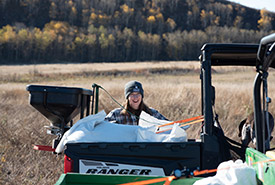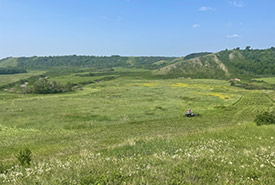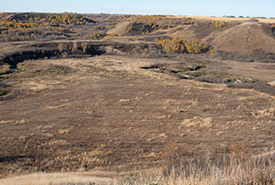Restoring nature at Echo Creek

Echo Creek restoration (Photo by Marla Anderson/ NCC staff)
In a world facing pressing challenges like climate change and rapid biodiversity loss, viable ecosystems emerge as a beacon of hope. Vital for both human health and the well-being of our planet, nature provides us with a wealth of essential services, ranging from the food on our tables to the improvement of our mental health.
Beneath the surface of our ecosystems lies untold treasures, their value only recognized when we delve deeper. Grasslands for instance, serve as natural water filters, ensuring the purity of this life-sustaining resource. Healthy habitats also contribute to cleaner air. But their contributions do not stop there. Grasslands, wetlands and forests act as natural flood barriers, guarding against flood waters. Additionally, these ecosystems are instrumental in storing carbon, an indispensable tool in slowing the pace of climate change.

Cutting cover crop at Echo Creek, SK (Photo by NCC)
Recognizing the urgency of the situation, the United Nations launched the Decade on Ecosystem Restoration (2021–2030). This global call to action aims to prevent, halt and reverse the degradation of ecosystems across every continent and ocean. We have a vital role to play in curbing the biodiversity crisis, achieving global climate goals and enhancing human well-being.

Echo Creek restoration project – seeding over crop (Photo by NCC)
The Nature Conservancy of Canada (NCC) plays a vital role in conserving biodiversity, often embarking on ecosystem restoration in areas we protect. Echo Creek in Saskatchewan is a prime example, where we are restoring idle croplands overrun by invasive weeds. Over two years, we will take on these invaders through mowing and chemical control, followed by seeding native grasses and forbs.
Erosion along the creek threatens further habitat loss and sedimentation. We are working to restore the area by rallying community volunteers and planting native shrubs and willow staking. As trees and shrubs take root, they'll stabilize the banks, reduce runoff and lessen flooding. A healthy streambank fosters diverse species, enhances landscape connectivity and corridors for wildlife movement, curbs erosion, filters contaminants and boosts aquatic biodiversity. By working to restore our ecosystems, we can safeguard human health, conserve natural areas, and protect the wonders of nature for generations to come. To learn more, visit prairiegrasslands.ca.



